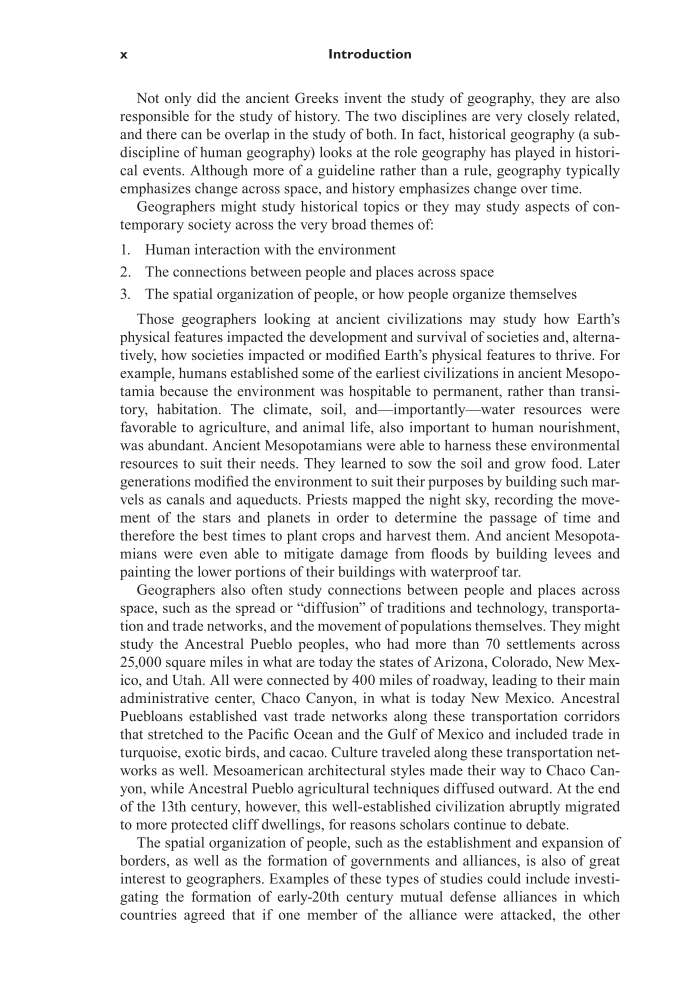x Introduction Not only did the ancient Greeks invent the study of geography, they are also responsible for the study of history. The two disciplines are very closely related, and there can be overlap in the study of both. In fact, historical geography (a sub- discipline of human geography) looks at the role geography has played in histori- cal events. Although more of a guideline rather than a rule, geography typically emphasizes change across space, and history emphasizes change over time. Geographers might study historical topics or they may study aspects of con- temporary society across the very broad themes of: 1. Human interaction with the environment 2. The connections between people and places across space 3. The spatial organization of people, or how people organize themselves Those geographers looking at ancient civilizations may study how Earth’s physical features impacted the development and survival of societies and, alterna- tively, how societies impacted or modified Earth’s physical features to thrive. For example, humans established some of the earliest civilizations in ancient Mesopo- tamia because the environment was hospitable to permanent, rather than transi- tory, habitation. The climate, soil, and—importantly—water resources were favorable to agriculture, and animal life, also important to human nourishment, was abundant. Ancient Mesopotamians were able to harness these environmental resources to suit their needs. They learned to sow the soil and grow food. Later generations modified the environment to suit their purposes by building such mar- vels as canals and aqueducts. Priests mapped the night sky, recording the move- ment of the stars and planets in order to determine the passage of time and therefore the best times to plant crops and harvest them. And ancient Mesopota- mians were even able to mitigate damage from floods by building levees and painting the lower portions of their buildings with waterproof tar. Geographers also often study connections between people and places across space, such as the spread or “diffusion” of traditions and technology, transporta- tion and trade networks, and the movement of populations themselves. They might study the Ancestral Pueblo peoples, who had more than 70 settlements across 25,000 square miles in what are today the states of Arizona, Colorado, New Mex- ico, and Utah. All were connected by 400 miles of roadway, leading to their main administrative center, Chaco Canyon, in what is today New Mexico. Ancestral Puebloans established vast trade networks along these transportation corridors that stretched to the Pacific Ocean and the Gulf of Mexico and included trade in turquoise, exotic birds, and cacao. Culture traveled along these transportation net- works as well. Mesoamerican architectural styles made their way to Chaco Can- yon, while Ancestral Pueblo agricultural techniques diffused outward. At the end of the 13th century, however, this well-established civilization abruptly migrated to more protected cliff dwellings, for reasons scholars continue to debate. The spatial organization of people, such as the establishment and expansion of borders, as well as the formation of governments and alliances, is also of great interest to geographers. Examples of these types of studies could include investi- gating the formation of early-20th century mutual defense alliances in which countries agreed that if one member of the alliance were attacked, the other
Document Details My Account Print multiple pages
Print
You have printed 0 times in the last 24 hours.
Your print count will reset on at .
You may print 0 more time(s) before then.
You may print a maximum of 0 pages at a time.























































































































































































































































































































































































